
In Greek mythology, Andromeda is the daughter of the king of Aethiopia, Cepheus, and his wife, Cassiopeia. When Cassiopeia boasts that she is more beautiful than the Nereids, Poseidon sends the sea monster Cetus to ravage the coast of Aethiopia as divine punishment. Andromeda is chained to a rock as a sacrifice to sate the monster, but is saved from death by Perseus, who marries her and takes her to Greece to reign as his queen.

Tiziano Vecelli or Vecellio, known in English as Titian, was an Italian (Venetian) painter of the Renaissance, considered the most important member of the 16th-century Venetian school. He was born in Pieve di Cadore, near Belluno. During his lifetime he was often called da Cadore, 'from Cadore', taken from his native region.
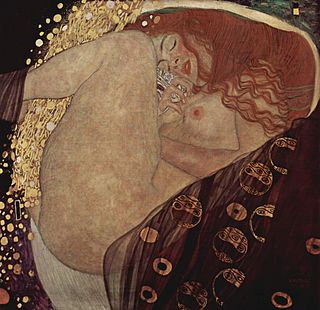
Danaë is an oil painting by Gustav Klimt, created in 1907. An example of Symbolism, the canvas measures 77 x 83 cm, and is in the Galerie Würthle in Vienna. Danaë was a popular subject in the early 1900s for many artists; she was used as the quintessential symbol of divine love, and transcendence.

François Lemoyne or François Le Moine was a French rococo painter. He was a winner of the Prix de Rome, professor of the Académie de peinture et de sculpture, and Premier peintre du Roi to Louis XV. He was tutor to Charles-Joseph Natoire and François Boucher.
Events from the year 1611 in art.

Diana and Actaeon is a painting by the Italian Renaissance master Titian, finished in 1556–1559, and is considered amongst Titian's greatest works. It portrays the moment in which the hunter Actaeon bursts in where the goddess Diana and her nymphs are bathing. Diana is furious, and will turn Actaeon into a stag, who is then pursued and killed by his own hounds, a scene Titian later painted in his The Death of Actaeon.
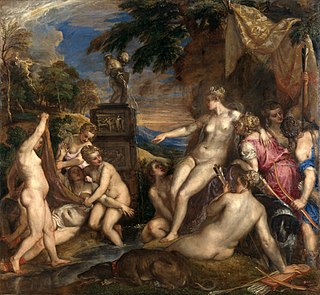
Diana and Callisto is a painting completed between 1556 and 1559 by the Italian late Renaissance artist Titian. It portrays the moment in which the goddess Diana discovers that her maid Callisto has become pregnant by Jupiter. The painting was jointly purchased by the National Gallery and the Scottish National Gallery for £45 million in March 2012. Along with its companion painting Diana and Actaeon it is displayed on an alternating basis between London and Edinburgh. There is a later version by Titian and his workshop in the Kunsthistorisches Museum in Vienna.

The Death of Actaeon is a late work by the Italian Renaissance painter Titian, painted in oil on canvas from about 1559 to his death in 1576 and now in the National Gallery in London. It is very probably one of the two paintings the artist stated he had started and hopes to finish in a letter to their commissioner Philip II of Spain during June 1559. However, most of Titian's work on this painting possibly dates to the late 1560s, but with touches from the 1570s. Titian seems never to have resolved it to his satisfaction, and the painting apparently remained in his studio until his death in 1576. There has been considerable debate as to whether it is finished or not, as with other very late Titians, such as the Flaying of Marsyas, which unlike this has a signature, perhaps an indication of completion.

Andromeda Chained to the Rocks (1630) is a 34 by 24.5 cm oil-on-panel painting by the Dutch Golden Age painter Rembrandt. It is now in the Mauritshuis, The Hague, Netherlands. Andromeda represents Rembrandt's first full length mythological female nude history painting and is taken from a story in Ovid's Metamorphoses.

Sir Peter Paul Rubens was a Flemish artist and diplomat from the Duchy of Brabant in the Southern Netherlands. He is considered the most influential artist of the Flemish Baroque tradition. Rubens's highly charged compositions reference erudite aspects of classical and Christian history. His unique and immensely popular Baroque style emphasized movement, colour, and sensuality, which followed the immediate, dramatic artistic style promoted in the Counter-Reformation. Rubens was a painter producing altarpieces, portraits, landscapes, and history paintings of mythological and allegorical subjects. He was also a prolific designer of cartoons for the Flemish tapestry workshops and of frontispieces for the publishers in Antwerp.

Perseus Freeing Andromeda is a painting by the Flemish artist Peter Paul Rubens, done in 1622. It is now in the Gemäldegalerie, Berlin, Germany.

The Venetian painter Titian and his workshop made at least six versions of the same composition showing Danaë, painted between about 1544 and the 1560s. The scene is based on the mythological princess Danaë, as – very briefly – recounted by the Roman poet Ovid, and at greater length by Boccaccio. She was isolated in a bronze tower following a prophecy that her firstborn would eventually kill her father. Although aware of the consequences, Danaë was seduced and became pregnant by Zeus, who, inflamed by lust, descended from Mount Olympus to seduce her in the form of a shower of gold.
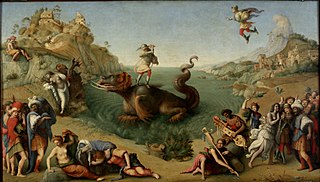
Perseus Freeing Andromeda or Liberation of Andromeda is a painting created by Piero di Cosimo, during the Italian Renaissance. The painting was praised by critics and art historians for its aesthetic, cosmological and political implications. The painting is a recreation of the myth of Perseus, the demi-god, who slays the sea monster and saves the beautiful Andromeda. The painting is based on a story created by the ancient Roman writer Ovid, in the Metamorphoses. The themes of the painting include platonic love, ideal beauty, marriage, and natural beauty. The painting includes portraits of the Medici family and many of Florentine's elite upper ruling class as characters in the story of Perseus Freeing Andromeda. The painting also represents a paragone between painting and sculpture. The painting resides in the Uffizi in Florence.

The Birth of the Milky Way, also sometimes known as The Origin of the Milky Way, is an oil-on-canvas painting by the Flemish artist Peter Paul Rubens, produced between 1636 and 1638 and featuring the Greco-Roman myth of the origin of the Milky Way. The painting depicts Hera (Juno), spilling her breast milk, the infant Heracles (Hercules) and Zeus (Jupiter) in the background, identifiable by his eagle and lightning bolts. Hera's face is modelled on Rubens' wife, Hélène Fourment. The carriage is pulled by peacocks, a bird which the ancient Greeks and Romans considered sacred to both themselves and to Hera/Juno, as a result of their ability to signal changes in weather through cries and hence their perceived connection to the gods. Due to the dark background of the night sky the figures gain a greater sense of volume.

Perseus and Andromeda is a 1622 painting in the Hermitage Museum by the Flemish artist Peter Paul Rubens of the ancient Greek myth of Perseus and Andromeda after the former's defeat of the Gorgon. The composition is similar to that of an earlier painting by Rubens, Perseus frees Andromeda.
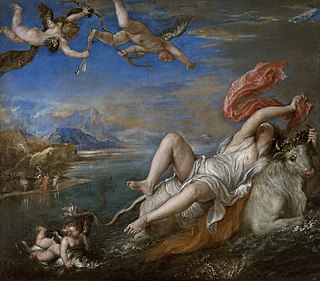
The Rape of Europa is a painting by the Venetian artist Titian, painted ca. 1560–1562. It is in the permanent collection of the Isabella Stewart Gardner Museum of Boston, Massachusetts. The oil-on-canvas painting measures 178 by 205 centimetres.

Perseus and Andromeda is an oil painting by Lord Frederic Leighton. Completed in 1891, the year it was displayed at the Royal Academy of Arts, it depicts the Greek mythological story of Andromeda. In contrast to the basis of a classical tale, Leighton used a Gothic style for the artwork. The painting is in the collection of National Museums Liverpool at the Walker Art Gallery.
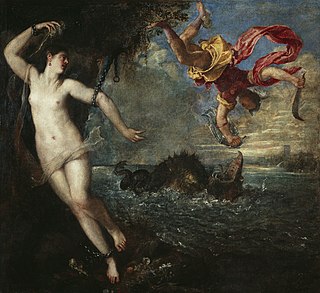
Perseus and Andromeda is a painting by the Italian Renaissance artist Titian, now in the Wallace Collection in London. It was painted in 1554–1556 as part of a series of mythological paintings called "poesie" ("poetry") intended for King Philip II of Spain. The paintings took subjects from the Roman poet Ovid's Metamorphoses, in this case Book IV, lines 663–752, and all featured female nudes.
Perseus Freeing Andromeda is the title of several paintings, including:

Perseus and Andromeda is a 1723 oil on canvas painting by the French artist François Lemoyne (1688-1737), measuring 184 by 151 cm. It is now in the Wallace Collection in London, which also houses Titian's version of the same subject, whose composition Lemoyne borrowed and reversed for his work.

















